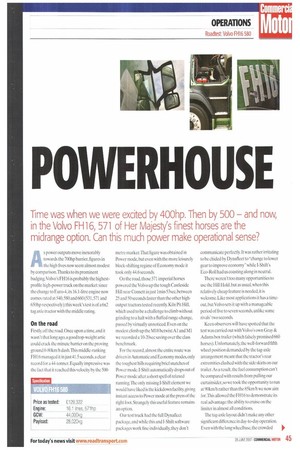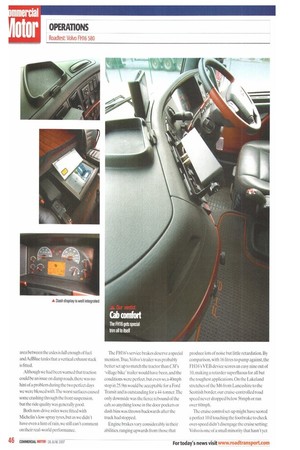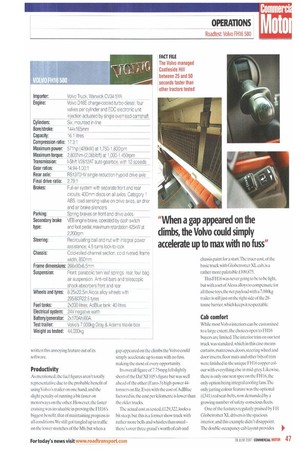POWERHOUSE
Page 45

Page 46

Page 47

Page 48

If you've noticed an error in this article please click here to report it so we can fix it.
Time was when we were excited by 400hp. Then by 500 — and now, in the Volvo FH 16, 571 of Her Majesty's finest horses are the midrange option. Can this much power make operational sense?
As power outputs move inexorably towards the 700hp barrier,figures in the high fives now seem almost modest by corn parison.Thanks to its prominent badging, Volvo's FH16 is probably the highestprofile high-power truck on the market: since the change to Euro-4, its 16.1-litre engine now comes rated at 540,580 and 660 (531,571 and 650hp respectively); this week's test is of a 6x2 tag axle tractor with the middle rating.
On the road Firsilv, off the road. Once upon a time, and it wasn't that long ago, a good top-weight artic could crack the minute harrier on the proving ground 0-80km/h dash.This middle-ranking FH16 managed it in just 41.5 seconds, a clear record for a 44-torincr. Equally impressive was the fact that it reached this velocity by the 500 metre marker, That figure was obtained in Power mode, but even with the more leisurely block-shifting regime of Economy mode it took only 44,6 seconds.
On the road, those 571 imperial horses powered the Volvo up the tough Castleside Hill near Consett in just lmin 53sec, between 25 and 50 seconds faster than the other highoutput tractors tested recently. Kiln Pit Hill, which used to be a challenge to climb without grinding to a halt with a fluffed range-change, passed by virtually unnoticed. Even on the modest climb up the MI 8 betwixt Al and M1 we recorded a 10-20sec saving over the class benchmark.
For the record, almost the entire route was driven in Automatic and Economy modes, only the toughest hills requiring brief snatches of Power mode.1-Shift automatically drops out of Power mode after a short spell of relaxed running.The only missing I-Shift element we would have liked is the kickdown facility, giving instant access to Power mode at the press of the right foot. Strangely this useful feature remains an option.
Our test truck had the full Dynafleet package, and while this and I-Shift software packages work fine individually, they don't communicate perfectly. It was rather irritating to be chided by Dynafleet to "change to lower gear to improve economy" while I-Shift's Eco-Roll had us coasting along in neutral.
There weren't too many opportunities to use the Hill Hold, but as usual, when this relatively cheap feature is needed, it is welcome. Like most applications it has a timeout, but Volvo sets it up with a manageable period of five to seven seconds, unlike some rivals' two seconds.
Keen observers will have spotted that the test was carried out with Volvo's own Gray & Adams box trailer (which falsely promised 660 horses). Unfortunately, the well-forward fifth wheel position demanded by the tag-axle arrangement meant that the tractor's rear extremities clashed with the side skirts on our trailer. As a result, the fuel consumption can't be compared with results from pulling our curtainsider, so we took the opportunity to run at YOktn/h rather than the 85knilh we now aim for.lhis allowed the FH16 to demonstrate its real advantage: the ability to cruise on the limiter in almost all conditions.
The tag-axle layout didn't make any other significant difference in day-to-day operation. Even with the long wheelbase, the crowded
area between the axles is full enough of fuel and AdBlue tanks that a vertical exhaust stack is fitted.
Although we had been warned that traction could be an issue on damp roads, there was no hint of a problem during the two perfect days we were blessed with:The worst surfaces caused some crashing through the front suspension, but the ride quality was generally good.
Both non-drive axles were fitted with Michelin's low-spray tyres, but as we didn't have even a hint of rain, we still can't comment on their real-world performance. The FH16's service brakes deserve a special mention.True,Volvo's trailer was probably better set up to match the tractor than CM's 'village bike' trailer would have been, and the conditions were perfect, hut even so, a 40mph stop in 25.9m would be acceptable for a Ford Transit and is outstanding for a 44-tonner.The only downside was the fierce rebound of the cab, so anything loose in the door pockets or dash bins was thrown backwards after the truck had stopped.
Engine brakes vary considerably in their abilities, ranging upwards from those that produce lots of noise but little retardation. By comparison, with 16 litres to pump against, the FH16'sVEB device scores an easy nine out of 10, making a retarder superfluous for all but the toughest applications. On the Lakeland stretches of the M6 from Lancashire to the Scottish border. our cruise-controlled road speed never dropped below 56mph or ran over 60mph.
The cruise control set-up might have scored a perfect 10 it' touching the foot brake to check over-speed didn't disengage the cruise setting; Volvo is one of a small minority that hasn't yet written this annoying feature out of its software.
Productivity As mentioned, the fuel figures aren't totally representative due to the probable benefit of using Volvo's trailer on one hand, and the slight penalty of running a bit faster on motorways on the other. However, the faster cruising was invaluable in proving the F1116's biggest benefit, that of maintaining progress in all conditions. We still got tangled up in traffic on the lower stretches of the M6, but when a gap appeared on the climbs the Volvo could simply accelerate up to max with no fuss, making the most of every opportunity.
Its overall figure of 7.75rnpg fell slightly short of the Daf X.F105's figure but was well ahead of the other (Euro-3) high-power 44tonners on file. Even with the cost of AdBlue factored in the cost per kilometre is lower than the older trucks.
The actual cost as tested,i 129,322, looks a bit steep, but this is a former show truck with rather more bells and whistles than usual— there's over three grand's worth of cab and chassis paint for a start.Thc truer cost. of the basic truck with Globetrotter XL cab, is a rather more palatable £109,875.
This FH16 was never going to be to be light, but with a set of Alcoa alloys to compensate for all those toys, the net payload with a 7,000kg trailer is still just on the right side of the 28tonne barrier, which keeps it respectable.
Cab comfort While most Volvo interiors can be customised to a large extent, the choices open to FH16 buyers are limited.The interior trim on our test truck was standard, which in this case means curtains, mattresses, doors, steer mg wheel and door inserts, floor mats and other bits of trim were finished in the unique FH16 copper colour with everything else in mid-grey. Likewise, there is only one seat spec on the FH16, the only option being integral cooling fans. The only jarring colour feature was the optional (041) red seat-belts, now demanded by a growing number of safety-conscious fleets.
One of the features regularly praised by FH Globetrotter XL drivers is the spacious interior, and this example didn't disappoint. The double-occupancy cab layout provides two bunks. with high-level storage lockers front and rear and built-in smoke detector for those for whom 1 July holds no fear.
The central rear locker provided a home to the Samsung microwave, which is fast becoming an essential on CM roadtests. In the all-important practical test, conducted at 50mph on the Al .our British Standard Ginster's Peppered Steak Slice was a little unevenly heated through, possibly thanks to some turntable slippage.A coffee pot was listed with the options but had been removed.
The under-bunk storage drawer between the seats contained a fridge below a slightly flimsy-feeling pull-out tabletop. There's no longer any other interior storage under the bunk access is only from outside but there is a sturdy safe for valuables at the left-hand end of the lower bunk.
The staggered interior sun visors, hacked up by an external visor, did their job effectively; poking out from the left-hand end of the visor is the latest rectangular front-view mirror, which gave better coverage than the previous circular item. Mind you, it did wobble unnervingly on bumpy surfaces.
As usual, the benefits of the excellent main mirrors are countered by their blindspot effects, but even as you read this. Volvo's improved mirrors are rolling off the production lines.
We occasionally had to check those mirrors to look for approaching emergency vehicles, but it was only a faint whistle from the turbo. The extra power of the 16-litre engine is not betrayed by the engine note, which frankly is disappointingly quiet.All we could detect was lots of distant humming.
The central dashtop houses the pop-up screen that displays the trip computer,sat-nav and rear camera among many other functions. There's excellent integration between the digital tachograph and the dash information display hut a mildly irritating tick-tick noise accompanied the unnecessary EU overspeed warning. Sector driving time, rest time and total daily driving time are all displayed in readable characters, and a discreet alarm warns of running out of time. We still managed to forget to press the rest button at the end of the first day, however.
The rest of the FH interior is well documented and remains a model of ergonomic clarity, with everything in a logical position and working as it should. •






























































































































































































